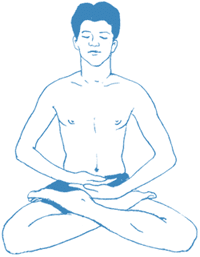- Improved flexibility, enhanced stamina, better mind and body coordination.
- Enhanced efficiency of your nervous and endocrine systems and internal organ.
- Control of your breathing and improved breathe quality.
- Though most of the yoga poses are designed for each and everyone but it is recommended to select poses according to your body endurance, mood and energy level.
- Start with easy to handle poses and work up to stronger ones.
- Breathe evenly through the nose throughout the postures.
- Get relaxed before and after yoga to avoid immediate rush into and out of a pose.
- Carefully notice if you feel any strain in a pose and stop immediately if it hurts.
- It is not recommended to practice in front of a mirror. Rather concentrate on how the pose feels, not what it looks like.
- The postures should be focused on getting relaxed without any strain to body.
Yoga assumes breath as a connecting link between the physical body and the mind. Controlled breathing practice has tremendous effect on state of mind and changes it positively. A breathing practice can last anything from two minutes to half an hour or more.
Tips to follow when practicing Breathing or Pranayama:
- The place selected for yoga must be free from distractions. While practicing yoga indoors, keep the windows open to allow plenty of fresh air into the room.
- Begin with trying pranayama lying down and then slowly concentrate to sit upright with your spine straight.
- Breathe evenly through the nose throughout the postures.
- Breathing must be free and in natural rhythm without any strain while doing pranayama.
- Take deep breathes gradually.
- Control breathing slowly and carefully.
- If you feel dizzy or light-headed, return to normal breathing.
- Make sure someone is near you when experimenting a new technique.
- Keep patience and do not expect immediate results and practice all exercises as slowly as you can.
Mudras are positions (mostly of the hands) channelize the body's energetic system and synchronize the flow of prana (life energy) within it. Mudras are easy and generally do not have any ill effects when used. The best time to practise Mudras is during the sitting phase after a posture and breathing session.
Tips to follow when practicing Mudras:
- Don't try hard – gently let your fingers to touch as guided.
- Get relaxed and let your mind and body to be in peace.
RELATED ARTICLES:
















